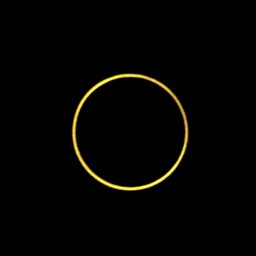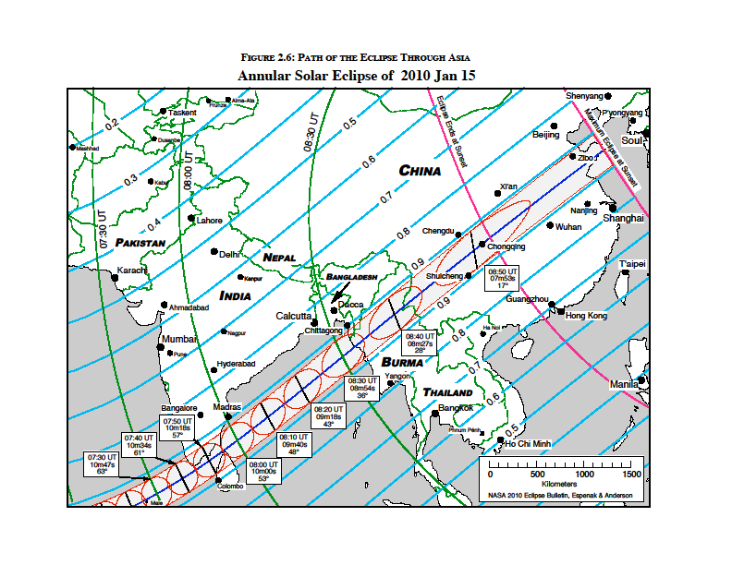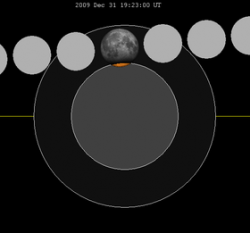THE NEXT LUNAR AND SOLAR ECLIPSE PAIR OF 2009-2010
The annular eclipse of 2010: A Sun with a black hole
The next eclipse of the Sun whose path passes over India is an annular one, due on the 15th January 2010 when the Moon will fail to completely cover the disc of the Sun. In such an event we get an unusual view of the eclipsed Sun as a very brightly lit thin rim with a dark central hole (the Moon), the magnitude being 0.956 at the central line. The corona of the Sun would not show up because the visible annulus of its disc simply outshines the relatively much feebler corona, in fact a million times fainter. Therefore, for the solar astronomer, an annular eclipse has no attraction to offer. The event will still arouse enough curiosity and has a great educational value in its own right. The path of annularity, over 300 km wide, shall pass over southernmost parts of India - around Kanya Kumari and Adam's Bridge and parts of Tamil Nadu and Sri Lanka. The timings indicated in the attached figure taken from the NASA website are in UT; for IST, add 5h 30m. Some major Indian towns that fall within the path of annularity are: Thiruvanthapuram, Nagercoil, Tuticorin, Panakkulam, Madurai, Thanjavur and Rameswaram etc, in order of the passage of the umbra. For example, at Nagercoil, the mid eclipse occurs at 13:15 hrs IST, the Sun (& the Moon) being at an elevation of 58 deg. On the northern edge of the path lie Cuddalore, Neyveli, Erode, Kodaikanal, Madurai etc. In the rest of India the eclipse will be partial only.

Annular solar eclipse, May 10, 1994 (Grant W McKinney)
At the time of annularity, the most interesting thing to look for would be Venus, just about 1.25 degrees away from the Sun (geocentric value). On the day of the eclipse Venus will be to the far side from the Earth, at 1.711 AU from us (1 AU = 14,95,97,870.691 km). It would shine at -3.8 mag. Locating it is a challenging task. Try out a pinhole arrangement.
An annular eclipse of the Sun, including its partial phases, is not safe to view directly. An appropriate filter is a must.
The annular eclipse of the Sun is going to be visible across Africa, the Indian Ocean, Maldives, India, Sri Lanka, and south-east Asia. The annular phase begins at 05:13:54 UT in the Central African Republic and ends on the Chinese Yellow Sea coast at 08:59:01 UT. The time of maximum eclipse is 07:06:31 UT and the annular phase lasts over 11 min 08 sec, much longer than a total. Maximum width of the band is 333 km. Over Maldives, the full annularity will be for 10.8 min.
The partial eclipse will be visible over eastern parts of Africa, south-east Europe, the Middle East, and south-east Asia between 04:05:26 UT and 10:07:33 UT.
Details at: eclipse.gsfc.nasa.gov/SEmono/ASE2010/ASE2010.html
VANTAGE POINTS
One of the best places to view the annular eclipse of 2010 from is somewhere between Dhanushkodi, near Rameswaram and the Kodandaramar Temple islet, 2 km from the central line. One might need permission for entering Dhanushkodi ruins from the coast guard post for the place is just 10 km from the Sri Lankan coast. The next best places are Thiruvananthapuram, and Kanya Kumari, 22 km north of the central line.

Rameswaram (9.95N, 79.12E) timings:
C1 05h 44m 32.5s UT
C2 07 47 03.3
Max 07 52 10.1
C3 07 57 15
C4 09 39 52.1
The next time the path of totality of a solar eclipse passes over India will be on 20th March 2034 only. The major towns that shall fall within the path are Baramula, Srinagar, Anantnag, Kargil and Leh in the state of Jammu and Kashmir etc.
FACT SHEET
Some general information on the Sun, the Moon and solar eclipses is as follows that will help one appreciate the event more fully. While the actual diameters of the Sun and the Moon are vastly different, their angular diameters are very similar, the very basis of a grand spectacle these give rise to whenever the Earth, the Moon and the Sun get so aligned as to cause an eclipse of the Sun by the Moon while the Earth and the Moon go about in their respective orbits. The respective angular diameters as seen from the Earth are:
| Maximum | Minimum | |
| Sun | 32'36" | 31'32" |
| Moon | 33'39" | 29'22" |
The Sun is not a perfect sphere. It is slightly swollen at the equator, the equatorial radius being 6,95,500 km, and flattening 9.10-6. That needs to be covered up for a total solar eclipse. The Earth’s aphelion occurs some time between Jul 3-6 and the perihelion in the first week of January.
Since the orbits do not lie in a plane, that of the Moon inclined by 5 deg 08 min, a solar eclipse does not happen on every New Moon day. In a Century, there are a total of 238 solar eclipses. The maximum number of solar eclipses in a year is five whereas minimum number is two. The next time the path of totality passes over India will be on 20th March 2034 only. So, just do not miss the annular solar eclipse of Jan 15 next.
EARTH (NASA data):
Earth radius: 6378.1 km (Req), 6366.8 km (Rp), 6371 km (R_ave)
Perihelion – 14,70,95,271 km – In 2009 it happened on Jan 4; in 2010 on Jan 3
Aphelion 15,20,91,174 km - In 2009 it happened on Jul 4; in 2010 on Jul 6
Year after year, the passages differ in dates by a few days. In between the apses, the Sun’s diameter differs by a little over 3%.
MOON
| Apogee | Perigee |
| 4,06,601 km | 3,56,566 km |
Moon radius: 1737.5 km.
Eccentricity of the Moon's orbit: e = 0.0549.
The eclipses of 2009
The IYA 2009 has had the distinction of having a total of six eclipses. The year is peculiar enough to have had triple eclipses in Jun-Jul lastand is part of a double eclipse that lies ahead. There have already been five eclipses - of the Sun on Jan 26 and Jul 22 and of the Moon on Feb 9, Jul 7 and Aug 6-7, 2009 respectively. Of these the third that took place on the night of 6/7 Aug was a part of triple eclipses of Jul-Aug 2009.
Once in a Blue Moon lunar eclipse
The International Year of Astronomy IYA 2009 closes, and the year 2010 opens, in India, with witnessing a lunar eclipse. It is the last eclipse of the year 2009, a penumbral lunar eclipse that shall occur on the night of Dec 31, 2009/Jan 1, 2010, during 22:47 - 02:58 hrs IST and be visible from all over India.
A lunar eclipse happens on a Full Moon day while a solar eclipse takes place on a New Moon day. The phrase Blue Moon refers to something rare. In essence, it is the occurrence of an extra Full Moon in the same month. This happens because in a calendar year, there would be twelve lunar cycles plus a period of about eleven days. Year after year these accumulate so that once in three years, or more exactly, 2.7154 years, we get to have two Full Moons fall in the same month. The forthcoming lunar eclipse is that of a Blue Moon. The Moon itself is not going to look blue! A view of the eclipsed Moon with a binocular will be just breathtaking. The last time a lunar eclipse took place on a New Year day was in the year 1741. The next year-end eclipse would be in 2066 while the new-year lunar eclipse in 2048 only. This fact makes the forthcoming lunar eclipse truly a 'Once in a Blue Moon' eclipse.

Dec 31 2009/Jan 1 2010 Lunar eclipse chart (Wikipedia)
The grey circle above is the umbra while the black annulus around it is the penumbra.
In a penumbral eclipse the Moon is somewhat dimmed. Near the mid eclipse, the Moon's edge brushes umbra too at which time it would be a total penumbral plus part umbral, giving up about 7.6 % of the disc, though not totally dark. The umbral phase is in between 12:23 - 01:23 am and belongs to the New Year. On the day the Moon is 57.4 ER (Earth Radii) from us, very close to its perigee.
This eclipse in fact is the first of double eclipses, followed by an annular solar eclipse on Jan 15, 2010. Just because there are two or three eclipses in a row is nothing to be alarmed about. The orbits and positions of the Moon and the Earth with respect to the Sun can make it happen. In fact two consecutive eclipses in a year are more common. The last triple eclipses occurred in the year 2000 and then 2009. In between, there have been many doubles.
IIA Astronomers observe the Total Solar Eclipse of July 22, 2009 from China
Eclipse images taken by IIA from different locations within India

